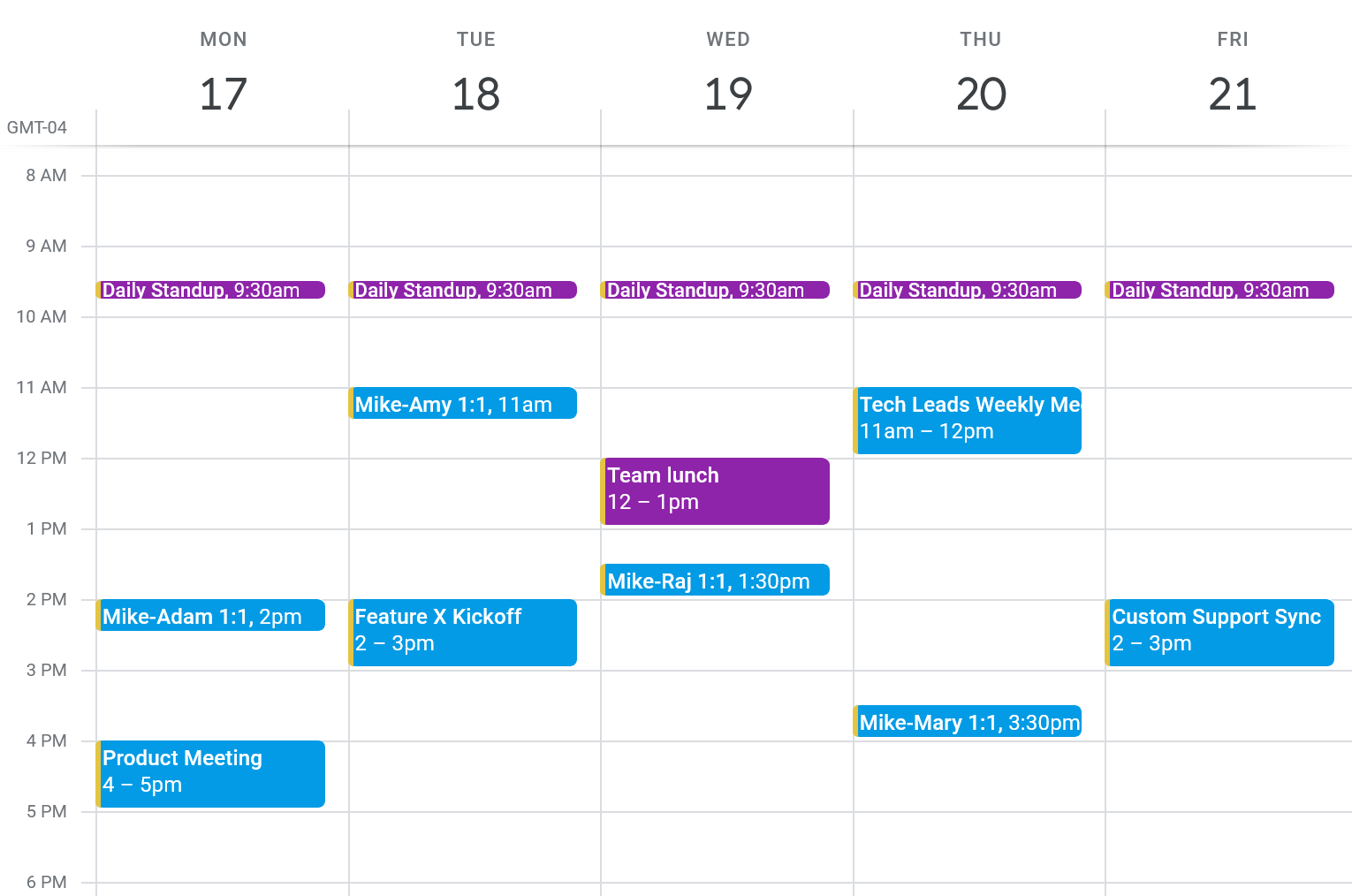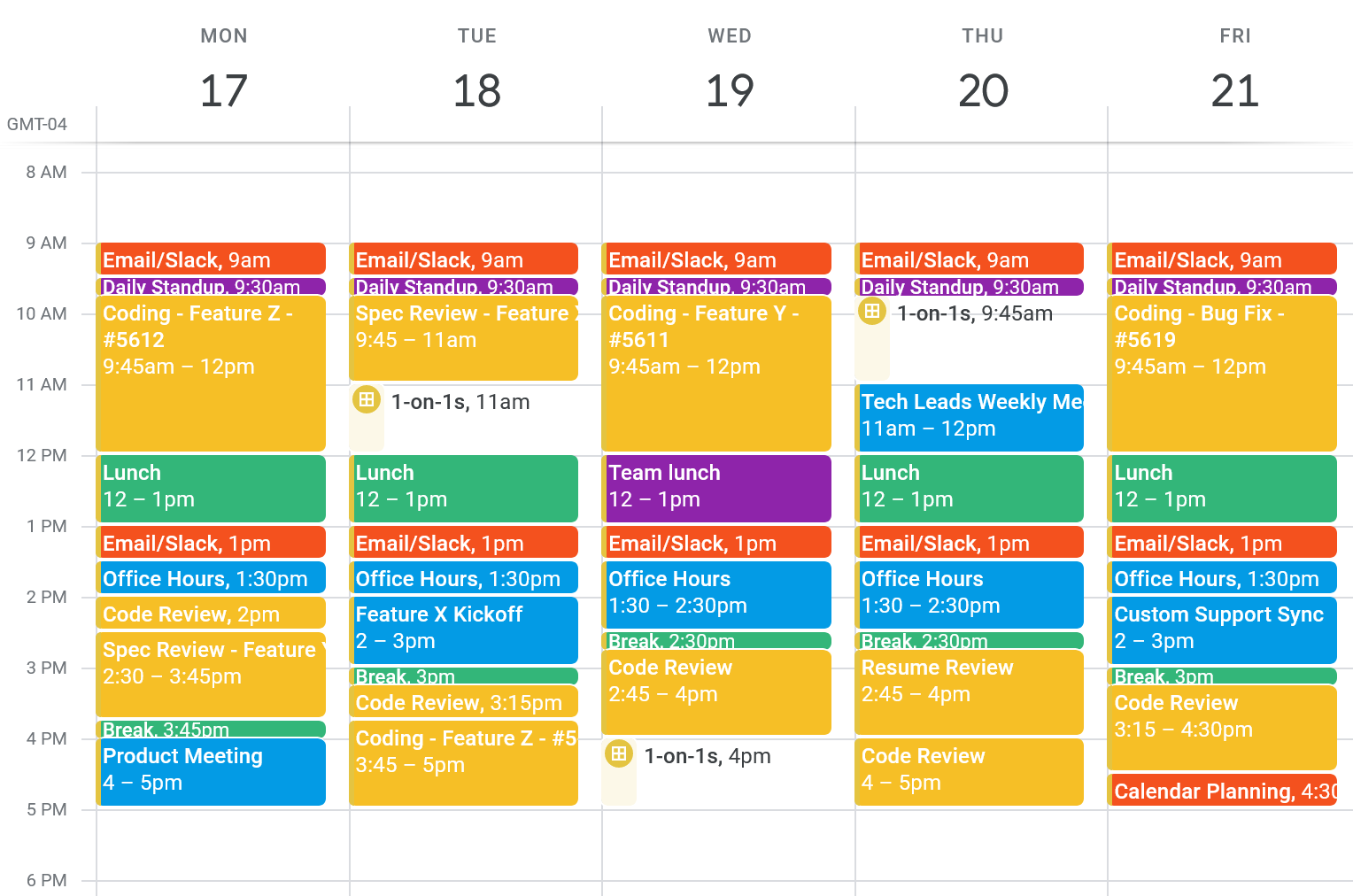If you have followed the advice from the previous two posts, you’re now in a situation where you’ve trained your colleagues not to interrupt you randomly. You’ve stopped rewarding the types of interruptions you don’t want so those have grown fewer and farther between. You’ve blocked off time on your calendar for your tasks and have rejected meeting requests sent during those times. You’ve picked specific times during the day to respond to email and Slack. But you’re feeling uncomfortable. It seems like you’re ignoring your colleagues. You like your new level of productivity, but you don’t like feeling that you’re letting your teammates down. This is where office hours come in.
Batching interruptions with office hours
Colleges and universities typically require their professors to have office hours to make it easier for students to get additional help or ask questions outside of class. Professors post the hours that they will be in their office each week, and students know that they can always stop in (or schedule a time in that block) to get additional help. This frees up the professor from needing to deal with constant questions and interruptions from all of their students. As a tech lead, you can do the same thing.
Remember all of those random “hey” messages from part 1 of this series? You have probably encountered something similar, where people just need a few minutes of your time to answer a question. This is part of your job as a tech lead and it will never go away. What you can do instead is to concentrate all of these interruptions into a few specific blocks of time throughout your week. So instead of getting random requests throughout the day, you can let your teammates know that you will gladly answer their questions during office hours.
Because you’re already time blocking your calendar, you can add in blocks for office hours several times a week. Depending on your interrupt rate, you may want to block off an hour each day or two hours on Mondays, Wednesdays, and Fridays…the exact schedule can be adapted to what you need. The most important thing is that this is a block of time where you are concentrating interruptions instead of having them occur intermittently throughout the day.
If you’re using Google Calendar, there’s a feature called appointment schedules1 that fits this use case perfectly. Instead of just blocking off time on your calendar as a meeting, you can create an appointment schedule and let people request pieces of that slot. When people view your calendar, they will see your appointment schedule with a link to schedule within that slot. If you’re not using Google Calendar, create a block on your calendar labeled “Office Hours” and set that time to “Available” instead of “Busy” to make it easy for others to see when you’re free.
Initially, you might get some pushback on this change. People will feel like they are being less productive if they can’t get ahold of you immediately. For this reason, I recommend starting with one office hour block every day until you and your team have adjusted (in extreme cases, two blocks per day might be useful). If people know the longest they’ll need to wait to talk to you is 24 hours, then they’ll feel less anxious about it. Later, you can adjust the schedule to better match the needs of your team.
After a few weeks you will likely find that you are getting fewer of these scheduled interruptions than you were getting unscheduled interruptions. Why? Because people are getting themselves unstuck while waiting to meet with you. This is a good thing as the team is learning to be more resilient and solve problems on their own, freeing up your time to focus on your deliverables.
At this point you might be thinking, well that’s great for technical questions, but what can I do about all those other meetings?
Appointment blocks for other meetings
Blocking off time for office hours is really just a specific type of appointment block on your calendar, which is to say these are regularly occurring blocks of time for potential appointments with other people. Tech leads often get pulled into different types of meetings: 1-on-1s with other engineers, meetings with managers, product or architectural reviews, and more. If there are regular meetings you need to attend, the good news is that those will already be represented on your calendar, and I’d encourage you to set them up as recurring meetings so you don’t have to think about them. For other categories of meetings where people request your time, it’s best to set up appointment blocks for those purposes.
Exactly how you set this up is up to you. Maybe you want specific blocks for 1-on-1s that are separate from other types of meetings. Maybe there’s just one big “meetings” block where you’ll allow any type of meeting to be scheduled. You can choose the system that makes the most sense based on the meetings you regularly attend. And do be kind to your colleagues: Blocking off meeting times in the early morning or late night won’t solve the problem. Make sure your appointment slots are at the times when people are most likely to request them.
Of course, there will be times when people will need to schedule outside of your stated appointment times, but hopefully they will reach out to you ahead of time to let you know why. You can’t tell your VP of engineering that you’re not available for a last-minute meeting, of course. But as you start to manage your calendar better, you’ll find patterns for when certain meetings pop up and you can then adjust your time blocks accordingly.
Before and after calendars
Previously, I showed you an example of what your calendar might have looked like before time blocking, and it was as follows:

Next, you learned to use time blocking to put tasks on your calendar and come up with an initial view of your week. Now when you add in appointment blocks, you’ll get an even better view of where you’ll have specific types of meetings:

This is a fully time-blocked calendar with appointment blocks for office hours and 1-on-1s, the two most common types of recurring meetings requested of tech leads. The office hours are fairly regular, occurring after lunch for either 30 or 60 minutes while the 1-on-1 blocks occur Tuesday through Thursday at different times, depending on availability. Keep in mind that even though these times are blocked off, you may not have any appointments during those times. The goal is to schedule them into your calendar so that you know when they will happen if needed.
Keep in mind that you need not block every hour of every day. When you do your weekly calendar planning on Friday, you may find that your tasks and appointment blocks don’t fill up your calendar, and that’s okay. As long as you have time blocked off for everything you know you need to do, there is nothing wrong with leaving open slots on your calendar. You may even find that by Friday all of those open slots have been filled.
But how do you transition to this new system?
Communication is key
In order to better control your interrupt rate, you must communicate what interruptions are acceptable and when. A sudden shift in your behavior causes unnecessary disruption to the team and makes it more difficult for team members to accept. You can minimize the disruption by letting people know of the change ahead of time and being open to feedback about how it’s going. A good approach is to explain that you’re trying this new process for six weeks and will adjust based on feedback after that.
Here’s an example of an email that resets expectations around interruptions:
Hi everyone,
As I’ve been growing in my role as tech lead, I’ve found that I haven’t been as efficient with my time as I should be, and I’m not able to be as effective as I’d like. To address that, I’m making some changes to how I work starting next Monday, and I wanted to let you know in case there are any questions or concerns. The changes I’ll be making are as follows:
- Slack: I’m going to be limiting the amount of time I spend in Slack. I’ve found it difficult to concentrate on my deliverables with the constant flurry of notifications. I’ll be checking Slack three times each day, and I’ll respond to any messages during those time periods only. If you need a short answer to something, Slack is the best way to reach me.
- Technical Help: I’m blocking off 2 p.m. to 3 p.m. every day as my office hours for technical questions. Please schedule a 15-minute block during that time and I’ll be happy to work directly with you. That way, I’ll be able to give you my complete attention at a time when I know I can focus.
- 1-on-1s: If you need to schedule a longer discussion with me, please use the 1-on-1 slots I have on my calendar.
- Other Meetings: If you need to schedule any other type of meetings, please find an open slot on my calendar. If you can’t find one in the timeframe you need, please let me know and I’ll adjust my schedule.
- Emergencies: If there’s any kind of emergency that requires my immediate attention, please call (don’t text) my cell phone. My text notifications are off, but calls always come through.
I’m going to try this for six weeks to see how it works, and I’d love your feedback along the way so I can make adjustments if anything isn’t working. In the meantime, feel free to reach out if you have any questions or concerns.
When you send an email like this, you are less likely to get pushback to the change. Explicitly asking for feedback and letting people ask questions lessens the chances of problems. You’re also not placing blame or telling people not to bother you. Instead, you’re reframing how you’d like to be approached for different types of discussions and how to schedule them. This clarity can, in some cases, make people more likely to come to you because they no longer fear interrupting you at an inappropriate time.
Conclusion
The role of tech lead is a challenging one, and oftentimes, your manager wasn’t a tech lead and may not be able to give you the best guidance on how to spend your time. Finding the right balance between helping others and working on your own deliverables is key, and the best way to find that balance is to manage the frequency with which you are interrupted.
One way to manage your interrupt rate is to invert your calendar with time blocking, ensuring that each task you want time to do is scheduled at a particular time. This will prevent people from scheduling meetings at those times. As long as you dedicate yourself to the task at hand by closing other applications and avoiding other interruptions, you’ll find that you will get more done. Blocking out time for email and checking Slack ensures that you’re still in regular communication with teammates throughout the day.
To offset the loss of those random interruptions, scheduling regular office hours lets team members know when they can expect you to be available. The exact cadence of these office hours is up to you and your team to determine but should occur several times each week. You may need to go through several iterations of office hours scheduling before finding the one that works best for your team. You can make similar appointment blocks for other types of regular meetings such as 1-on-1s or product reviews.
Being a tech lead is largely about the effective allocation of your time to help the team achieve their goals. The tools discussed in this post can help you reclaim your day and make you more effective at delivering results while allowing the team to grow and learn without constant interruption.





